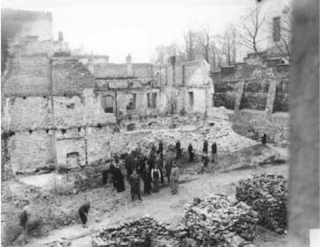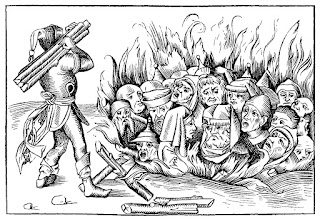Burning of the Bedzin Great Synagogue, 1939
9 September, 1939
Bedzin, Poland
My grandmother was born in Bedzin, Poland in 1921. Her family was fortunate enough to immigrate to Canada before the outbreak of World War II, but many Jews remained in Bedzin when the Nazis marched into town on September 4, 1939. The Nazis quickly went to work rounding up notable residents for interrogation, plundering goods and humiliating Jews by shaving their beards. Others were shot and had their bodies mutilated. However, the Jews of Bedzin were not yet sure what to expect from the occupiers.
By the end of the week, they knew.
That Shabbat, as Jews gathered to pray in the Great Synagogue of Bedzin, the Nazis broke into the buildings adjacent to the synagogue, threw in hand grenades and order the Jews out. About 200 Jews ran to the synagogue for refuge, but the Nazis barred the doors, set fire to the building and burned it to the ground. Jews who managed to escape the flames were shot by German soldiers. A few managed to escape into a nearby church. Approximately 60 people were burned to death inside the synagogue. To add insult to injury, several of the Jews who escaped were shot the next day, accused of having set the fire themselves. Others survivors were forced to clear the ruins of the building.
As a young boy, Maurice Siidmarc witnessed the blaze from a window in his attic across the road and heard people shouting for help. He saw people with their clothes burned off and their bodies disfigured.
Alexander Ferson was also living in Bedzin. He recalls
Similar scenes played out in other communities in the region as this calculated campaign of terror played out.
Bedzin, Poland
 |
| Ruins of Bedzin Synagogue |
By the end of the week, they knew.
That Shabbat, as Jews gathered to pray in the Great Synagogue of Bedzin, the Nazis broke into the buildings adjacent to the synagogue, threw in hand grenades and order the Jews out. About 200 Jews ran to the synagogue for refuge, but the Nazis barred the doors, set fire to the building and burned it to the ground. Jews who managed to escape the flames were shot by German soldiers. A few managed to escape into a nearby church. Approximately 60 people were burned to death inside the synagogue. To add insult to injury, several of the Jews who escaped were shot the next day, accused of having set the fire themselves. Others survivors were forced to clear the ruins of the building.
As a young boy, Maurice Siidmarc witnessed the blaze from a window in his attic across the road and heard people shouting for help. He saw people with their clothes burned off and their bodies disfigured.
Alexander Ferson was also living in Bedzin. He recalls
"It was Friday evening in the first week of the war. Jewish people were gathering at the synagogue. Just as they had done for centuries. The Germans were now in the town. They surrounded the area of the main synagogue. With the congregation inside the Germans locked the door and set the synagogue alight." (Shadows of the Holocaust)Irene Gdesz, a non-Jewish girl from the neighborhood, remembered
"the sound of screaming and the sight of the synagogue and houses in flames - as a well as the sight of people jumping into the river, crying and screaming, and the sight of blood all around." (Mary Fulbrook, A Small Town Near Auschwitz, 51)The Germans used this attack for several purposes. They wanted the Jews to panic and flee, advancing their cause of making the area free of Jews. In addition, by claiming that locals had started the fire, they hoped to drive a wedge between the Poles and Jews who might otherwise combine forces to resist the German advances. (A Small Town Near Auschwitz, 53-58)
Similar scenes played out in other communities in the region as this calculated campaign of terror played out.


Comments
Post a Comment